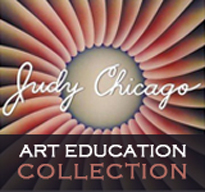Home › Forums › Archived DPCP Forum › News and Events (Archived) › The Dinner Party Curriculum in the Alibi
- This topic has 1 reply, 1 voice, and was last updated 10 years, 11 months ago by
JCAEC.
-
AuthorPosts
-
May 21, 2009 at 12:55 pm #1552
JCAEC
KeymasterIn the Art News section of the Alibi, Albuquerque New Mexico’s free weekly arts and entertainment newspaper, Erin Adair-Hodges reports on the Dinner Party Curriculum Project.
Read the article here http://alibi.com/index.php?story=27866&scn=artMay 21, 2009 at 1:02 pm #1553JCAEC
KeymasterArt News
The Chicago School of Art
The K-12 Dinner Party Curriculum
By Erin Adair-HodgesPanels from The Dinner Party The development of The K-12 Dinner Party Curriculum Project was born out of frustration.
While Judy Chicago, developer of The Dinner Party, and her husband, photographer Donald Woodman, were artists in residence at Vanderbilt University in 2005, Chicago was shown an article from an education magazine on a teacher’s use of The Dinner Party in class.Chicago’s work consists of a triangular table with place settings set for important female figures, such as Emily Dickinson, Kali, Sacajewea and Eleanor of Aquitaine. One of the intentions of the installation is to highlight the oft-ignored contributions of women, so when Chicago saw that this teacher’s class had instead created their own autobiographical plates, she was disturbed. There’s nothing wrong with that approach, she writes in an introduction to the curriculum, but “it is a mistake to claim that such a project has anything to do with The Dinner Party, which is about women’s achievements in history.”
The Dinner Party He response to the class project spurred her to think about developing guidelines for educators who want to use The Dinner Party, as many have done since the project’s completion in 1979. She and Woodman began working with Constance Bumgarner Gee, a professor of education at Vanderbilt. The hope was to guide students’ interactions with the piece in a way that honored the original intention of saving the role of powerful women from obscurity.
The Dinner Party itself was born out of collaboration, taking five years and the work of hundreds of people to come to fruition. The curriculum developed along a similar course, bringing in the experience and insight of educators. Chicago and Gee approached Kutztown University’s Marilyn Stewart, Peg Speirs and Carrie Nordlund to direct the project. They in turn enlisted a host of K-12 teachers to work together on developing lessons surrounding The Dinner Party. The teachers went back to their classrooms and implemented the strategies, highlighting what worked and refiguring what didn’t. The final curriculum is a product of this highly synergetic process.
The Dinner Party One aspect that both Chicago and the curriculum’s developers stress is the examination of content and context. Chicago says modern art education is obsessed with form—that is, how to create art—prioritizing format and technique. As an artist, she focuses on content (what the piece is saying) and the context of its creation (why it’s saying it, who it’s saying it to). The curriculum then asks students to investigate metaphor, symbolism and history as a way to understand the work’s meaning.The teaching of women’s history and achievements is often ghettoized, shoved into segments and special months, rarely integrated as part of a comprehensive program. The K-12 Dinner Party Curriculum Project isn’t slaying that particular behemoth, but it does attempt to create a space where students can realize that history isn’t just created by wars and shifting borders, but also by poetry, resistance and silent sacrifice.
Another goal of the program is to “emphasize that there are many ways to be involved in art,” Chicago says. “When it’s only hands-on art-making and they don’t end up being artists, they don’t have any other ideas that they could have a lifetime involvement with art other than making it.” Chicago, Woodman and the curriculum’s developers want to open students up to a world where participation in art includes curation, criticism, appreciation and patronage.
“There are all kinds of ways to be involved in art,” she says. “Hundreds of thousands of people who have seen The Dinner Party had a profound change and they learned a lot, and that’s what art should do.”
The K-12 Dinner Party Curriculum Project was officially launched on May 1 at the Roundhouse in Santa Fe. For more information on the curriculum, go to throughtheflower.org/dpcp.
-
AuthorPosts
- The forum ‘News and Events (Archived)’ is closed to new topics and replies.
